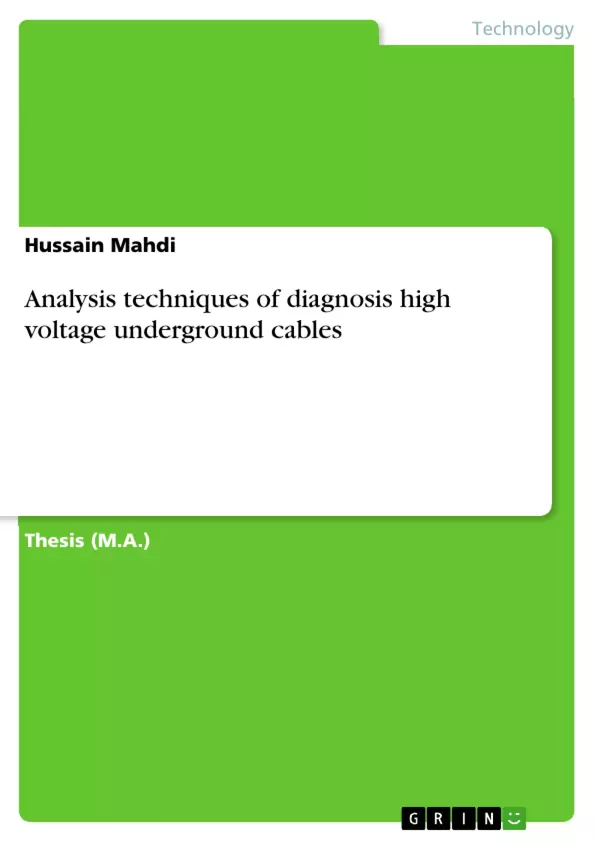This study is focused on installations and faults diagnosis of high voltage underground cables and examined on the various ways through which they can be identified and corrected. It has been found that wear and tear is one of the major issues leading to electric faults like power loss. There has been seen that several causes of failure which could be identified with them and analyze better ways of detecting them. So, it has been looked at how to detect degradation of insulation of the underground cable. After a thorough analysis of fault detection techniques have been explained, the pre-location fault techniques is described; I illustrated many methods which aid to discover the fault location. I also developed a method which contributes in pre-location of the fault based on Matlab simulation and mathematical slope equation. This method was invented after the observation that the voltages measured at the local and remote substations, after filtering and after Fourier analysis, showed a linear behavior that was proportional to the respective distances between the fault location and the mentioned substations or generators. Thus, the developed method exploits such a linearity to estimate the fault location by interpolation, assuming that the parameters of the line are previously known and that dedicated devices are located on site in both substations to provide post-fault measurements of the faulted line. Finally, I clarify many pin-pointing methods to precisely determine the fault location.
Inhaltsverzeichnis (Table of Contents)
- 1.Introduction...
- 1.1 Thesis Objectives ........
- 2. LITERATURE REVIEW.......
- 3. Differences between Underground Electrical Cables and Overhead Electrical Cables .......
- 4. Insulation and Methods of Protection of High Underground Cables ...............
- 4.1 Phase Comparison Scheme......
- 4.2 Directional Comparison Scheme...
Zielsetzung und Themenschwerpunkte (Objectives and Key Themes)
This thesis explores the diagnosis and correction of faults in high-voltage underground cables, investigating methods for detecting and addressing these issues. The study analyzes the factors contributing to cable degradation and failures, focusing on the impact of insulation deterioration on power loss.
- Fault Detection Techniques
- Fault Pre-Location Methods
- Matlab Simulation for Fault Location
- Analysis of Measurement Data
- Pin-pointing Methods for Fault Location
Zusammenfassung der Kapitel (Chapter Summaries)
- Introduction: This chapter introduces the thesis topic, highlighting the advantages and disadvantages of underground cables compared to overhead lines. It emphasizes the challenges associated with fault diagnosis in underground cables, including detection, routing, location, and correction.
- Literature Review: This chapter provides a comprehensive review of existing literature on fault detection and pre-location techniques in underground cables. It discusses various methods, including software-based, artificial intelligence (AI), traveling wave, and analytical procedures.
- Differences between Underground Electrical Cables and Overhead Electrical Cables: This chapter compares and contrasts the characteristics of underground cables and overhead lines, analyzing their respective strengths and weaknesses. It discusses the advantages of underground cables in terms of longevity and weather resistance, while acknowledging the higher initial costs and limitations in power transfer capacity.
- Insulation and Methods of Protection of High Underground Cables: This chapter explores the importance of insulation in high-voltage underground cables and discusses various methods for protection, including phase comparison and directional comparison schemes. It investigates how these schemes contribute to identifying and mitigating faults in the system.
Schlüsselwörter (Keywords)
The thesis revolves around the key themes of high voltage, underground cables, cable failure, pre-location detection, Matlab simulation, and pin-pointing. It delves into the analysis and diagnosis of faults in underground cables, exploring innovative methods for detecting, locating, and correcting these failures. The study employs Matlab simulation to develop a pre-location method and incorporates advanced pin-pointing techniques to precisely determine the fault location.
- Quote paper
- Hussain Mahdi (Author), 2015, Analysis techniques of diagnosis high voltage underground cables, Munich, GRIN Verlag, https://www.grin.com/document/337222



